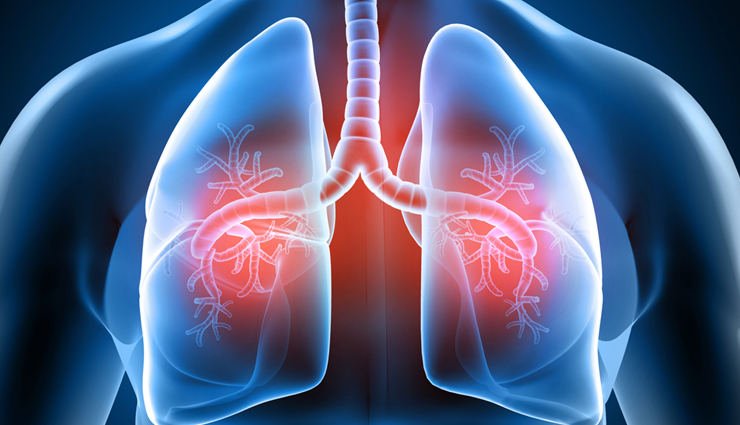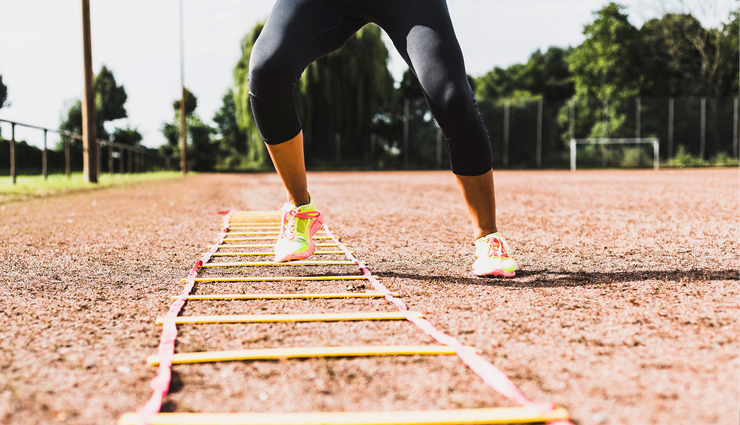- Home›
- Healthy Living›
- Improve Your Breathing Capacity: 11 Effective Exercises For Stronger Lung
Improve Your Breathing Capacity: 11 Effective Exercises For Stronger Lung
By: Priyanka Maheshwari Mon, 24 June 2024 10:47:56

Improving lung capacity can be an important aspect of maintaining overall respiratory health, and there are several exercises and activities that can help achieve this. Increasing lung capacity can lead to better oxygen delivery to the body, improved athletic performance, and better overall health outcomes for individuals with respiratory conditions. Some exercises that can help increase lung capacity include diaphragmatic breathing, pursed-lip breathing, deep breathing exercises, interval training, cardiovascular exercises, yoga, resistance training, cycling, swimming, and high altitude training. Each of these exercises and activities can help improve respiratory function in different ways, and incorporating a variety of exercises into your routine can lead to greater overall respiratory health and improved lung capacity. However, it is important to consult with a healthcare provider before starting any new exercise program, especially if you have a respiratory condition.

Diaphragmatic breathing
Yes, diaphragmatic breathing can help increase lung capacity. It involves using your diaphragm to take deep, slow breaths, which helps to expand the lungs and increase their capacity. Diaphragmatic breathing can also improve the efficiency of your breathing, allowing you to take in more oxygen with each breath and remove more carbon dioxide from your body. Practicing diaphragmatic breathing regularly can help to strengthen the diaphragm muscle and improve your overall lung function. It can be particularly helpful for people with chronic obstructive pulmonary disease (COPD), asthma, and other respiratory conditions.

Pursed-lip breathing
Pursed-lip breathing can help improve lung function and increase lung capacity. This breathing technique involves inhaling deeply through your nose and exhaling slowly through pursed lips, as if you were whistling. By exhaling through pursed lips, you create a slight back pressure in your airways, which can help to keep your airways open for longer and allow more air to flow out of your lungs. This can be particularly helpful for people with COPD, emphysema, or other lung conditions that make it difficult to exhale fully. Pursed-lip breathing can also help to slow down your breathing rate, making it easier to breathe and reducing the work of breathing. Practicing this technique regularly can help to strengthen the muscles involved in breathing and improve your overall lung function.

Deep breathing exercises
Deep breathing exercises can help increase lung capacity by encouraging you to take in more air with each breath. These exercises typically involve breathing in slowly and deeply through your nose, filling your lungs with air, holding your breath for a few seconds, and then exhaling slowly through your mouth. By taking in more air with each breath, you can increase the amount of oxygen that reaches your body's tissues and organs, which can improve overall respiratory function. Deep breathing exercises can also help to strengthen the muscles involved in breathing, including the diaphragm and intercostal muscles. Over time, this can lead to increased lung capacity and improved breathing efficiency. These exercises are particularly helpful for people with respiratory conditions like COPD, asthma, and bronchitis, as well as athletes and individuals looking to improve their overall fitness levels.

Interval training
Interval training can help increase lung capacity by challenging your respiratory system and forcing it to work harder. This type of exercise involves alternating periods of high-intensity exercise with periods of rest or lower-intensity exercise. During the high-intensity intervals, your body requires more oxygen, which means your respiratory system has to work harder to supply it. This can help improve lung function and increase lung capacity over time. Interval training can also improve overall fitness levels, which can make it easier to perform everyday activities without getting winded. It can be particularly beneficial for athletes and individuals with respiratory conditions, such as COPD or asthma, as it can help improve their exercise tolerance and overall respiratory function.

Cardiovascular exercises
Cardiovascular exercises can help increase lung capacity by improving the efficiency of your respiratory system. These exercises, such as running, cycling, or swimming, involve using large muscle groups and increasing your heart rate, which increases the amount of oxygen that your body requires. When you engage in cardiovascular exercise regularly, your respiratory system adapts by becoming more efficient at delivering oxygen to your muscles and removing carbon dioxide from your body. This can lead to an increase in lung capacity over time, allowing you to take in more air with each breath. Cardiovascular exercise can also improve overall fitness levels and decrease the risk of chronic diseases, such as heart disease, diabetes, and obesity, which can negatively impact respiratory function. It is particularly beneficial for individuals with respiratory conditions, as it can help improve exercise tolerance and overall lung function.

Yoga
Yoga can help increase lung capacity by improving respiratory function and encouraging deep, diaphragmatic breathing. Many yoga poses, such as the seated forward bend or the downward dog, require you to take deep, slow breaths that help expand your lungs and increase their capacity. Additionally, the physical movements and postures in yoga can help strengthen the muscles involved in breathing, including the diaphragm and intercostal muscles. This can lead to improved respiratory function and increased lung capacity over time. Yoga also helps to reduce stress and anxiety, which can negatively impact respiratory function, making it harder to breathe. By reducing stress levels, yoga can help improve breathing efficiency and lung function. Overall, regular yoga practice can be a helpful addition to a respiratory health routine for individuals with respiratory conditions, athletes, and individuals looking to improve their overall fitness levels.

Resistance training
Resistance training, also known as strength training or weightlifting, can indirectly increase lung capacity by improving overall fitness levels and respiratory muscle strength. When you engage in resistance training, you use large muscle groups to lift weights or perform other resistance-based exercises, which increases your heart rate and breathing rate. Over time, this type of exercise can improve cardiovascular health and increase the efficiency of your respiratory system, which can lead to increased lung capacity. Resistance training can also help strengthen the muscles involved in breathing, including the diaphragm and intercostal muscles, which can improve respiratory function and increase lung capacity over time. This type of exercise can be particularly beneficial for athletes and individuals with respiratory conditions, such as COPD or asthma, as it can improve exercise tolerance and overall respiratory function. However, it is important to consult with a healthcare provider before starting any new exercise program, especially if you have a respiratory condition.

Interval sprints
Interval sprints can help increase lung capacity by challenging your respiratory system and improving its efficiency. Interval sprints involve alternating periods of high-intensity running or sprinting with periods of rest or low-intensity exercise. During the high-intensity intervals, your body requires more oxygen, which means your respiratory system has to work harder to supply it. This can lead to an increase in lung capacity over time as your respiratory system adapts and becomes more efficient at delivering oxygen to your muscles and removing carbon dioxide from your body. Interval sprints can also improve cardiovascular fitness, which can lead to overall improvements in respiratory function. This type of exercise is particularly beneficial for athletes and individuals looking to improve their fitness levels or increase their exercise tolerance. However, it is important to consult with a healthcare provider before starting any new exercise program, especially if you have a respiratory condition.

Cycling
Cycling can help increase lung capacity by improving respiratory function and encouraging deep, rhythmic breathing. Cycling involves using large muscle groups in your legs and hips, which increases your heart rate and breathing rate. This increased demand for oxygen can lead to improved respiratory function and increased lung capacity over time. Cycling is also a low-impact exercise, which makes it a great option for individuals with respiratory conditions or joint pain. Additionally, cycling can improve cardiovascular fitness, which can lead to overall improvements in respiratory function. Regular cycling can also help to reduce stress and anxiety, which can negatively impact respiratory function. Overall, cycling is a great exercise for improving respiratory health and increasing lung capacity, and it can be a helpful addition to a respiratory health routine for individuals with respiratory conditions, athletes, and individuals looking to improve their overall fitness levels.

Swimming
Swimming is a great exercise for increasing lung capacity, as it requires controlled breathing and involves using a large number of muscles throughout the body. When you swim, you need to maintain a steady breathing pattern and take deep breaths, which can help expand your lungs and increase their capacity over time. Swimming also requires the use of the diaphragm and intercostal muscles, which can become stronger with regular swimming and improve overall respiratory function. Additionally, swimming is a low-impact exercise, which makes it a great option for individuals with respiratory conditions or joint pain. Swimming can also improve cardiovascular fitness, which can lead to overall improvements in respiratory function. Regular swimming can also help to reduce stress and anxiety, which can negatively impact respiratory function. Overall, swimming is a great exercise for improving respiratory health and increasing lung capacity, and it can be a helpful addition to a respiratory health routine for individuals with respiratory conditions, athletes, and individuals looking to improve their overall fitness levels.

High altitude training
High altitude training, also known as altitude training, can increase lung capacity by exposing the body to reduced oxygen levels, which can lead to increased production of red blood cells and improved respiratory function. When you train at high altitudes, such as above 5,000 feet, the air pressure and oxygen levels are lower, which means your body has to work harder to get the oxygen it needs. This can lead to an increase in lung capacity over time, as your respiratory system adapts and becomes more efficient at delivering oxygen to your muscles and removing carbon dioxide from your body. High altitude training can also improve cardiovascular fitness and overall endurance, which can lead to further improvements in respiratory function. However, high altitude training should be approached with caution and only under the guidance of a qualified professional, as there can be potential risks associated with exposure to high altitudes, such as altitude sickness.





